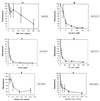Purification and characterization of PCR-inhibitory components in blood cells
- PMID: 11158094
- PMCID: PMC87763
- DOI: 10.1128/JCM.39.2.485-493.2001
Purification and characterization of PCR-inhibitory components in blood cells
Abstract
In a recent study, immunoglobulin G in human plasma was identified as a major inhibitor of diagnostic PCR (W. Abu Al-Soud, L. J. Jönsson, and P. Rådström. J. Clin. Microbiol. 38:345-350, 2000). In this study, two major PCR inhibitors in human blood cells were purified using size exclusion and anion-exchange chromatographic procedures. Based on N-terminal amino acid sequencing and electrophoretic analysis of the purified polypeptides, hemoglobin and lactoferrin were identified as PCR-inhibitor components in erythrocytes and leukocytes, respectively. When different concentrations of hemoglobin or lactoferrin were added to PCR mixtures of 25 microl containing 10 different thermostable DNA polymerases and 1 ng of Listeria monocytogenes DNA as template DNA, AmpliTaq Gold, Pwo, and Ultma were inhibited in the presence of < or = 1.3 microg of hemoglobin and < or = 25 ng of lactoferrin, while rTth and Tli were found to resist inhibition of at least 100 microg of hemoglobin. In addition, the quantitative effects of seven low-molecular-mass inhibitors, present in blood samples or degradation products of hemoglobin, on real-time DNA synthesis of rTth using the LightCycler Instrument were investigated. A reaction system based on a single-stranded poly(dA) template with an oligo(dT) primer annealed to the 3' end was used. It was found that the addition of 0.25 to 0.1 mg of bile per ml, 2.5 mM CaCl2, 0.25 mM EDTA, 5 microM FeCl3, and 0.01 IU of heparin per ml reduced the fluorescence to approximately 76, 70, 46, 17, and 51%, respectively. Finally, the effects of nine amplification facilitators were studied in the presence of hemoglobin and lactoferrin. Bovine serum albumin (BSA) was the most efficient amplification facilitator, so that the addition of 0.4% (wt/vol) BSA allowed AmpliTaq Gold to amplify DNA in the presence of 20 instead of 1 microg of hemoglobin and 500 instead of 5 ng of lactoferrin. Including 0.02% (wt/vol) gp32, a single-stranded-DNA binding protein, in the reaction mixture of AmpliTaq Gold was also found to reduce the inhibitory effects of hemoglobin and lactoferrin.
Figures



References
-
- Abu Al-Soud W, Lantz P-G, Bäckman A, Olcén P, Rådström P. A sample preparation method which facilitates detection of bacteria in blood cultures by the polymerase chain reaction. J Microbiol Methods. 1998;32:217–224.
-
- Akane A, Matsubara K, Nakamura H, Takahashi S, Kimura K. Identification of the heme compound copurified with deoxyribonucleic acid (DNA) from bloodstains, a major inhibitor of polymerase chain reaction (PCR) amplification. Forensic Sci. 1994;39:362–372. - PubMed
-
- Akane A, Matsubara K, Nakamura H, Takahashi S, Kimura K. Purification of highly degraded DNA by gel filtration for PCR. Bio Techniques. 1994;16:235–238. - PubMed
Publication types
MeSH terms
Substances
LinkOut - more resources
Full Text Sources
Other Literature Sources

